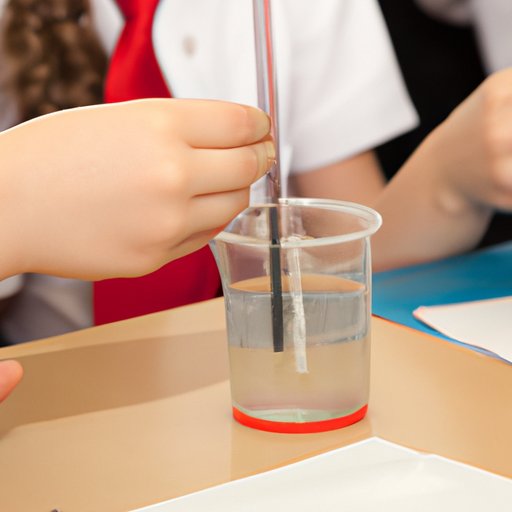Introduction
The scientific method is a systematic approach to solving problems and understanding the natural world. It is used by scientists to generate knowledge, draw conclusions, and make predictions about the physical universe. The scientific method is based on observation, hypothesis testing, experimentation, and analysis of data. It relies on repeatable experiments that can be verified by others.

Explaining the Basics of the Scientific Method
The scientific method begins with observation – noting something in the natural world. From these observations, hypotheses are formulated. A hypothesis is an educated guess or explanation for why something occurs. Experiments are then conducted to test the hypothesis. The results of these experiments are then analyzed, and a conclusion is drawn. This process is then repeated until a satisfactory answer is reached.
Outlining the Steps of the Scientific Method
The scientific method involves following a series of steps:
- Identifying a Problem or Question: The first step is to identify a problem or question that needs to be answered.
- Gathering Information: Next, relevant information is collected from previous studies, books, journals, and other sources.
- Formulating a Hypothesis: After gathering the necessary information, a hypothesis is formulated. A hypothesis is an educated guess or explanation for why something occurs.
- Conducting Experiments: Experiments are then conducted to test the hypothesis. These experiments must be carefully designed and controlled so that the results are valid.
- Analyzing Results: The results of the experiments are then analyzed. Data is collected and evaluated to determine if the hypothesis is supported or refuted.
- Drawing Conclusions: Once the results have been analyzed, a conclusion is drawn. The conclusion should be based on the evidence gathered during the experiment.
Examining the Role of the Scientific Method in Problem-solving
The scientific method can be used to solve everyday problems. For example, if someone has a problem with their car not starting, they could use the scientific method to troubleshoot the issue. First, they would identify the problem (the car won’t start). Next, they would gather information about the issue (researching possible causes). They would then formulate a hypothesis (the battery is dead). To test this hypothesis, they would conduct an experiment (checking the battery voltage). If the experiment supports the hypothesis, the problem is solved. If not, they would move on to the next possible cause.

Describing How the Scientific Method is Used in Research
The scientific method is also used in research. In research, the scientific method involves designing experiments, collecting data, analyzing results, and interpreting findings. Experiments must be carefully designed to ensure that the results are valid. Data must be collected in a consistent manner and accurately recorded. The results must then be analyzed to determine if the hypothesis was supported or refuted. Finally, the findings must be interpreted and reported.

Investigating the Impact of the Scientific Method on Modern Science
The scientific method has had a profound impact on modern science. The process of observation, hypothesis testing, experimentation, and analysis of data has enabled scientists to uncover new knowledge about the physical universe. As Albert Einstein said, “The whole of science is nothing more than a refinement of everyday thinking.” Through the scientific method, scientists have been able to refine their thinking and gain a better understanding of the world around them.
Comparing the Scientific Method with Other Forms of Inquiry
The scientific method is different from other forms of inquiry. Unlike other forms of inquiry, the scientific method relies on repeatable experiments that can be verified by others. It also requires careful observation, accurate record keeping, and rigorous analysis of data. Furthermore, the scientific method is focused on testing hypotheses and drawing conclusions based on the evidence. By contrast, other forms of inquiry may focus on generating ideas or exploring possibilities.
Demonstrating the Application of the Scientific Method to Everyday Situations
The scientific method can be applied to everyday situations. For example, if a person wants to know why their favorite plant isn’t growing as well as it used to, they could use the scientific method to investigate the problem. First, they would identify the problem (the plant isn’t growing as well as it used to). Next, they would gather information about the issue (researching possible causes). Then, they would formulate a hypothesis (the soil is too dry). To test this hypothesis, they would conduct an experiment (watering the plant more frequently). If the experiment supports the hypothesis, the problem is solved. If not, they would move on to the next possible cause.
Conclusion
The scientific method is a systematic approach to solving problems and understanding the natural world. It is used by scientists to generate knowledge, draw conclusions, and make predictions about the physical universe. The scientific method is based on observation, hypothesis testing, experimentation, and analysis of data. It can also be used to solve everyday problems and is widely used in research. Finally, the scientific method has had a profound impact on modern science and society.
In summary, the scientific method is a powerful tool for understanding the world around us. It enables us to make sense of our observations and draw meaningful conclusions. Through the scientific method, we can gain a greater understanding of the physical universe and our place in it.
(Note: Is this article not meeting your expectations? Do you have knowledge or insights to share? Unlock new opportunities and expand your reach by joining our authors team. Click Registration to join us and share your expertise with our readers.)
